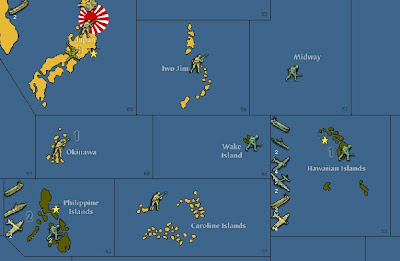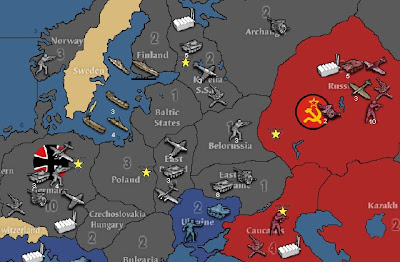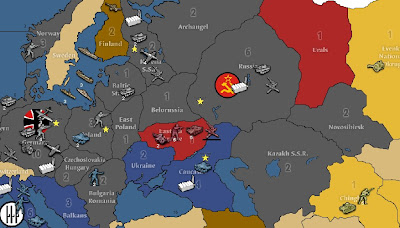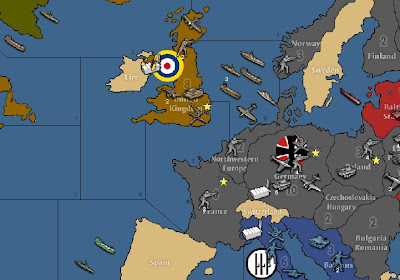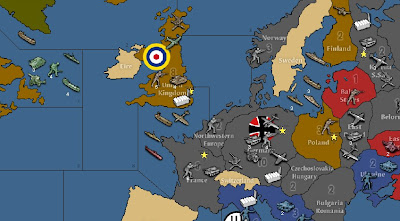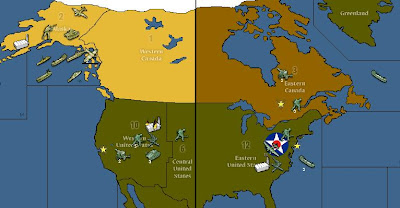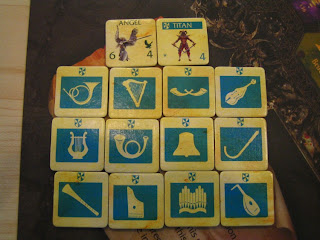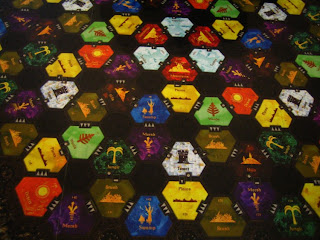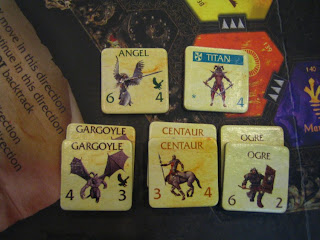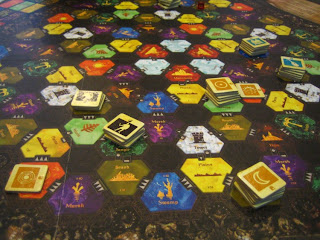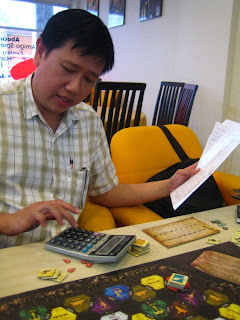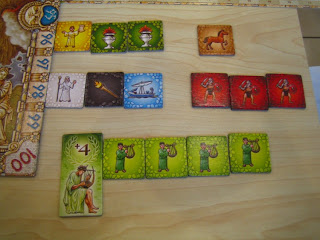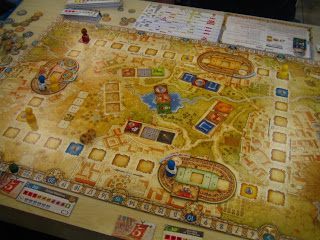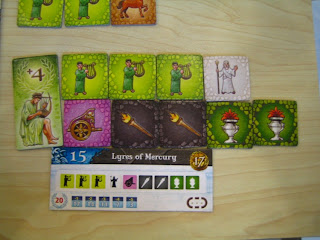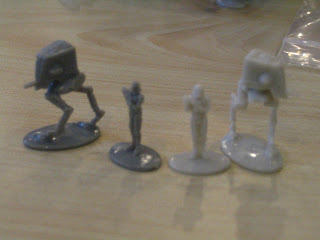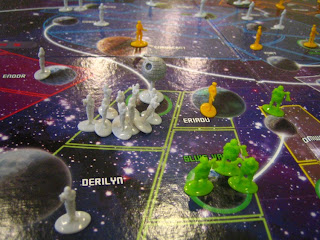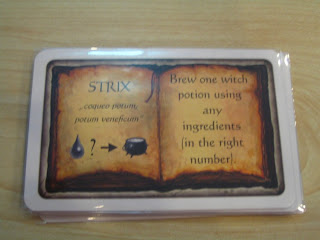When Axis & Allies Anniversary Edition was announced, there was no doubt I was going to buy it. It was only a matter of when. I have been a fan of the Axis & Allies series, although I don't get to play them very often. Just a few weeks ago, when my sister was preparing to return to Malaysia for Chinese New Year, I asked her to buy the game for me in Melbourne. The retail price was cheaper than in Malaysia, because of the weak Australian dollar. She had a friend coming back to KL, who did not have much luggage, and he was happy to bring the game to me. Huge box, flat but very wide.
I have now played one game of Axis & Allies Anniversary Edition. However, it was not using my newly purchased copy. It was a Play-by-e-mail (PBEM) game with Han, using the free program TripleA (version 1.0.3.0). This was my first time playing a PBEM game. It was a very exciting, addictive and memorable game. I lay awake at night thinking about the game. I kept studying the map and planning my next move, and the move after that, and then the one after that, while waiting for Han's response. I studied his options and possible moves. It was so tense that after finishing the game and Han suggested another go, switching sides and playing the other scenario, I said I needed a break to play some Eurogames on BSW. :-)
I won't write about the game that we played, since that will be a long blog entry. I'd like to write about what I think about the game after having completed the first game.
I had read much about the game before buying or playing it. I thought the game would become much longer than previous versions, but it wasn't the case at all. The game is physically much bigger, but there really aren't that many territories added onto the map compared to the previous 2004 version. The changes in the map are minor tweaks, rather than a major overhaul to add many more territories. So I think the game will only play slightly longer than Axis & Allies Revised (2004).
There are many improvements and changes made to the game, and I think they are all for the better, although to different degrees, in my opinion. I like the national objectives (an optional rule). They give an additional aspect to think about. You need to think of achieving yours as well as denying your opponents theirs. I'm not sure yet whether they unbalance the game, maybe time will tell, but they do add money into the game, allowing players to buy more things. I like that transports are now defenseless and must be protected by other naval units. It does mean you need to buy more naval units to protect them, but naval units are cheaper now too, which helps. I think the new cruiser unit is good. It attacks and defends on 3, and can shore-bombard during amphibious assaults. I never bought one in my first game, because they are $12 compared to $8 for destroyers, but I think they are a valid purchase option and not a meaningless one that some players feel they are, being too expensive for what they can do. I did use my initial cruisers to do a lot of shore-bombardment.
Research is improved, but I still think it is quite luck dependent, in terms of whether you achieve a breakthrough, and which technology you get. But at least now the money spent is not completely wasted, in a way. I don't think it's good to make research too deterministic. So I accept it as-is. I can't think of any better way to implement it, to be not too deterministic and not too luck-dependent. Maybe every country gets a semi-random free tech at the start of the game? Or something like the national advantages in Axis & Allies Revised (which is removed in Axis & Allies Anniversary Edition). I think the national advantages can be applied to Axis & Allies Anniversary Edition as a variant without much issue.
Italy is an interesting addition. I think it adds both strength and weakness to the Axis team. Strength because now between the UK and US turns, Italy can do something (damage control?), unlike in the past when Germany could not do anything and often suffered one-two-punch attacks from these two Allies. However Italy being a separate power also means Italian and German forces cannot do attacks together. In the past Italian forces were treated and represented as German ones. I think this makes things interesting.
In terms of the map graphics, I am in the minority, preferring the Axis & Allies Revised graphics and colour scheme. Most people seem to prefer the latest one or the original one. I think the map in Revised is cleaner and has a serious tone. The older one is a bit too light. The newest one is a bit too busy. Anyway, to me it's a minor thing, as long as the map is functional.
Bombers and naval units are cheaper now, making it more feasible to buy more of them, which I think is good. Strategic bombing runs are slightly different. I think it ends up just costing the victim money like previously, except there can be a delay in paying up, because the victim may decide not to repair his factory immediately. So, some flexibility for the victim.
A summary of my view of the main changes after just one game (+ means I like, = means I'm neutral):
- National objectives: ++
- Italy: +
- Strategic Bombing Runs: =
- Researth: =
- Unit costs: ++
- Map: +
- Graphics: =
I definitely will not go back to Revised, especially since Anniversary Edition really isn't much longer or more complex than I had initially thought.
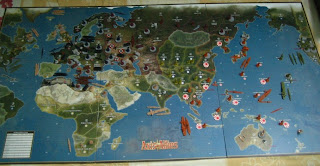
The 1942 scenario setup. I have not had the chance to play my copy, but I still wanted to set it up just to gawk.

The Pacific theatre. Japan has already conquered most of the Pacific islands.
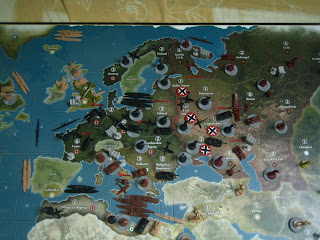
The European theatre. German troops are already at the gates of Moscow.

India, China and South East Asia. There are now Chinese troops, and they are controlled by the American player.

North Africa. Italy has a huge Mediterranean fleet. The game board is made up of three separate pieces. Thus the waterfall where the British destroyer is. I set up the game on an unused bed which is not exactly flat.
Playing a PBEM game gave me much time to think about the game and to explore the possibilities of every turn quite exhaustively. I never was an expert Axis & Allies player. Having played this very exciting PBEM game, I am reminded of the many strategy articles that I have read in the past (which were for the 1984 edition), and I am appreciating those strategies better. They are mostly still very applicable to the Anniversary Edition.
Axis & Allies is very much a game about... (some may be surprised...) shopping! You need to plan your unit purchases carefully. You buy units at the start of your turn, before you make combat moves, and you can only use your new units next turn. So you don't know what the battle outcomes will be for your current turn, and you need to already plan what you want to do in your next turn, even your next 2 to 3 turns. This is one area where Axis & Allies is much better than Risk. In Risk, the board is too dynamic. Often you get a whole bunch of units at the start of your turn, dump them into one territory, and use that big stack to wreak havoc, leaving a trail of destruction and eventually-thinned-out forces, until your stack runs out of steam.
However, despite the advance planning and strategic element of the game, Axis & Allies should be taken as a light game. There is quite a fair bit of luck in the game, because of the dice. Good players will be able to maximise chances of success and minimise risk, a better player will still win more often, but sometimes the best laid plans can be completely ruined by unlucky die rolls. So I imagine that when good players play optimally, things will boil down to calculated risks, and some gambles. The game should be enjoyed like you are watching events unfold, watching history play out. The game can be very enjoyable when everyone plays well, even if some players sometimes get royally screwed by bad die rolls. One should just laugh about those, e.g. when my lowly isolated death-wish British destroyer in the Indian Ocean attacked Han's Japanese carrier with 2 fighters, and killed 1 carrier and 1 fighter before being sunk. The captain deserves a medal of honour.
Another reason that I think the game should be played lightly is it doesn't really last that many rounds. Our game lasted 7 rounds. Strictly speaking the game had not ended, as in the required number of victory cities had not been captured yet, but we agreed to end the game as by that time the eventual winner was obvious. So although you can and should plan a few turns ahead, there aren't really that many rounds in the game. Well, I guess that depends on the players. Maybe among the top players the game can become a long stalemate.
When evaluating Eurogames I often think about whether there are many meaningful and tough decisions. When I apply that to Axis & Allies Anniversary Edition, I find that indeed there are many interesting and difficult decisions to be made. The game setup already contains many choices. The players have to decide where to attack, where to reinforce, which area to focus their effort, what general strategy to pursue, offensive or defensive. You need to decide how much risk you want to take. Bigger risks can mean bigger rewards. Or do you want to be conservative, which means fewers gains, and lower income, even though you conserve your forces?
The first one or two rounds may feel a little scripted, as there are only that many different options that you can think of based on the starting setup. However as the story unfolds, you will need to adapt to the new situation. The gameboard will gradually "clean up", as the initial troops at the front lines are worn down, and the troops that you have built during the game take up their positions. You will see more and more the results of your decisions since the start of the game, i.e. you don't have anyone else to blame now. As the board "cleans up", there may be fewer hotspots on the board, because you have consolidated your forces. Despite the fewer hotspots, I think the game gets more and more interesting, because you gradually see the fruits of your strategy. There will be some key fronts being contested. Sometimes troops will build up, and both sides hesitate to make the first major attack. There will be some skirmishes, but both sides try to conserve forces and consolidate forces, in preparation for the climatic battle. It is very exciting and I get very anxious and tense with anticipation. When is the right time to attack? Are my defenses strong enough to withstand the assault? What if I lose the battle, what next? What's my contingency?
The game can be chess-like, as in you will think "if I do this, then he may do this, and I would have to do that". It is very interesting to analyse the board and decide what you want to do next, because of the uncertainty in the battle results. You can calculate the odds, but the results are never guaranteed.
I find that I have a tendency to be bunch up my units, often at the cost of leaving many territories lightly defended. I tend to think of divide-and-conquer, i.e. if I have a few smaller / medium stacks of units, they can get easily destroyed individually. So I tend to group my units into big armies or fleets, with cheap units to take hits during battles, and expensive ones to deal maximum damage. However I'm not 100% sure this is always a good idea, because sometimes I tend to lose territories because of this, and even though the territories may not be high valued, every little bit does add up, and having more territories also means you more space for maneuvering. I need to rethink this in my next game.
I have never rated the previous versions and variations of Axis & Allies a 10. I think I may just do it for this Anniversary Edition.
Update - 12 Mar 2009. I wrote an extension to this review.

